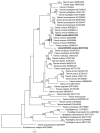Intestinal Parasites of Neotropical Wild Jaguars, Pumas, Ocelots, and Jaguarundis in Colombia: Old Friends Brought Back from Oblivion and New Insights
- PMID: 34209062
- PMCID: PMC8308835
- DOI: 10.3390/pathogens10070822
Intestinal Parasites of Neotropical Wild Jaguars, Pumas, Ocelots, and Jaguarundis in Colombia: Old Friends Brought Back from Oblivion and New Insights
Abstract
Neotropical wild felids (NWF) are obligate carnivore species present in Central and South America, and some are considered endangered due to constantly decreasing populations. NWF can become infected by a wide range of protozoan and metazoan parasites, some of them affecting their health conditions and others having anthropozoonotic relevance. Parasitological studies on NWF are still very scarce, and most data originated from dead or captive animals. On this account, the current study aimed to characterize gastrointestinal parasites of free-ranging jaguars (Panthera onca), pumas (Puma concolor), ocelots (Leopardus pardalis), and jaguarundis (Herpailurus yagouaroundi), i.e., four out of six NWF species endemic to Colombia. Fecal samples from jaguars (n = 10) and ocelots (n = 4) were collected between 2012 and 2017 as part of the Jaguar Corridor Initiative from six geographic locations in Colombia. In addition, cestode specimens were obtained during puma and jaguarundi necropsies. Scat samples were processed by standardized sodium acetate-acetic acid-formalin (SAF), sedimentation, and flotation techniques and by carbol fuchsin-stained fecal smears. Morphological evaluation of feces showed the presence of one cestode (Spirometra sp.), a nematode (Toxocara cati), an acanthocephalan (Oncicola sp.), and one cyst-forming coccidian (Cystoisospora-like oocysts). Feces oocysts were submitted to a Toxoplasma gondii-specific PCR for species identification, but no product was amplified. The cestodes isolated from a puma and jaguarundi were molecularly characterized by sequencing cytochrome c oxidase subunit I, identifying them as Taenia omissa and as a T. omissa sister lineage, respectively. These results collectively demonstrate the potential role of NWF as natural reservoir hosts for neglected zoonotic parasites (e.g., Spirometra sp., T. cati) and highlight their possible role in parasite transmission to human communities. Due to public health concerns, the occurrence of these parasites should be monitored in the future for appropriate zoonotic management practices in conservation strategies and wild felid health management programs.
Keywords: Cystoisospora sp.; Oncicola sp.; Spirometra sp.; Taenia omissa; Toxocara cati; jaguar; jaguarundi; ocelot; puma.
Conflict of interest statement
The authors declare no conflict of interest. No funder had any role in the design of the study, in the collection, analyses, or interpretation of data; in the writing of the manuscript; or in the decision to publish the results.
Figures





Similar articles
-
The Neglected Angio-Neurotrophic Parasite Gurltia paralysans (Nematoda: Angiostrongylidae): Northernmost South American Distribution, Current Knowledge, and Future Perspectives.Pathogens. 2021 Dec 9;10(12):1601. doi: 10.3390/pathogens10121601. Pathogens. 2021. PMID: 34959555 Free PMC article. Review.
-
A coprological survey of parasites of wild neotropical felidae.J Parasitol. 1986 Aug;72(4):517-20. J Parasitol. 1986. PMID: 3783346
-
Cross transmission of gastrointestinal nematodes between captive neotropical felids and feral cats.J Zoo Wildl Med. 2013 Dec;44(4):936-40. doi: 10.1638/2013-0015R2.1. J Zoo Wildl Med. 2013. PMID: 24450052
-
A Comparative Analysis of Genetic Diversity and Structure in Jaguars (Panthera onca), Pumas (Puma concolor), and Ocelots (Leopardus pardalis) in Fragmented Landscapes of a Critical Mesoamerican Linkage Zone.PLoS One. 2016 Mar 14;11(3):e0151043. doi: 10.1371/journal.pone.0151043. eCollection 2016. PLoS One. 2016. PMID: 26974968 Free PMC article.
-
International training programs in reproductive sciences for conservation of Latin American felids.Anim Reprod Sci. 2004 Jul;82-83:21-34. doi: 10.1016/j.anireprosci.2004.05.008. Anim Reprod Sci. 2004. PMID: 15271441 Review.
Cited by
-
Neglected zoonotic helminthiases in wild canids: new insights from South America.Front Vet Sci. 2023 Aug 11;10:1235182. doi: 10.3389/fvets.2023.1235182. eCollection 2023. Front Vet Sci. 2023. PMID: 37635759 Free PMC article.
-
Zoonotic risks and conservation challenges: Gastrointestinal parasites in wild mammals of Chitwan National Park, Nepal.Int J Parasitol Parasites Wildl. 2025 Jan 19;26:101041. doi: 10.1016/j.ijppaw.2025.101041. eCollection 2025 Apr. Int J Parasitol Parasites Wildl. 2025. PMID: 39911264 Free PMC article.
-
Felid Parasitoses, New Insights and Open Perspectives.Pathogens. 2021 Dec 28;11(1):28. doi: 10.3390/pathogens11010028. Pathogens. 2021. PMID: 35055976 Free PMC article.
-
New Insights into Gastrointestinal and Pulmonary Parasitofauna of Wild Eurasian lynx (Lynx lynx) in the Harz Mountains of Germany.Pathogens. 2021 Dec 20;10(12):1650. doi: 10.3390/pathogens10121650. Pathogens. 2021. PMID: 34959605 Free PMC article.
-
The Neglected Angio-Neurotrophic Parasite Gurltia paralysans (Nematoda: Angiostrongylidae): Northernmost South American Distribution, Current Knowledge, and Future Perspectives.Pathogens. 2021 Dec 9;10(12):1601. doi: 10.3390/pathogens10121601. Pathogens. 2021. PMID: 34959555 Free PMC article. Review.
References
-
- Kitchener A.C., Breitenmoser-Würsten C., Eizirik E., Gentry A., Werdelin L., Wilting A., Yamaguchi N., Abramov A., Christiansen P., Driscoll C., et al. A revised taxonomy of the Felidae. The final report of the Cat Classification Task Force of the IUCN/SSC Cat Specialist Group. [(accessed on 29 June 2021)];Cat News. 2017 Available online: https://repository.si.edu/handle/10088/32616.
-
- Montazeri M., Mikaeili Galeh T., Moosazadeh M., Sarvi S., Dodangeh S., Javidnia J., Sharif M., Daryani A. The global serological prevalence of Toxoplasma gondii in felids during the last five decades (1967–2017): A systematic review and meta-analysis. Parasit. Vectors. 2020;13:82. doi: 10.1186/s13071-020-3954-1. - DOI - PMC - PubMed
-
- Pena H.F.J., Marvulo M.F.V., Horta M.C., Silva M.A., Silva J.C.R., Siqueira D.B., Lima P.-A.C.P., Vitaliano S.N., Gennari S.M. Isolation and genetic characterisation of Toxoplasma gondii from a red-handed howler monkey (Alouatta belzebul), a jaguarundi (Puma yagouaroundi), and a black-eared opossum (Didelphis aurita) from Brazil. Vet. Parasitol. 2011;175:377–381. doi: 10.1016/j.vetpar.2010.10.015. - DOI - PubMed
LinkOut - more resources
Full Text Sources

